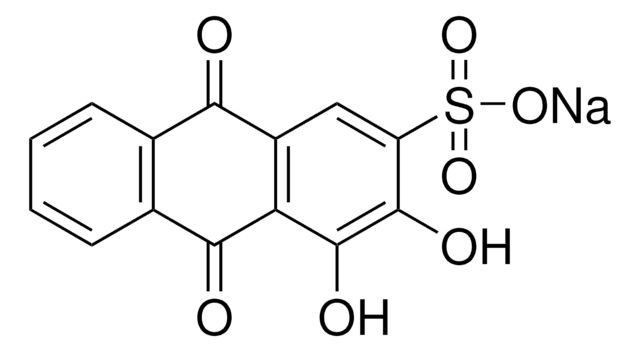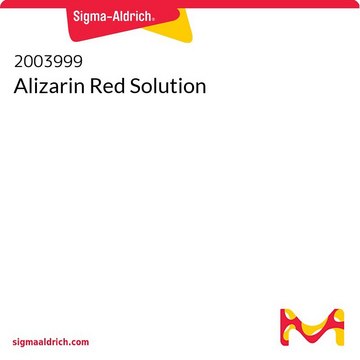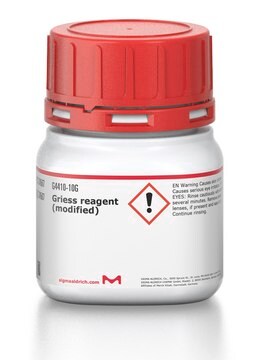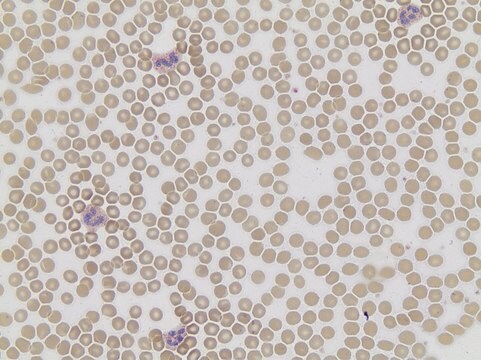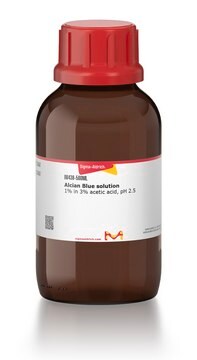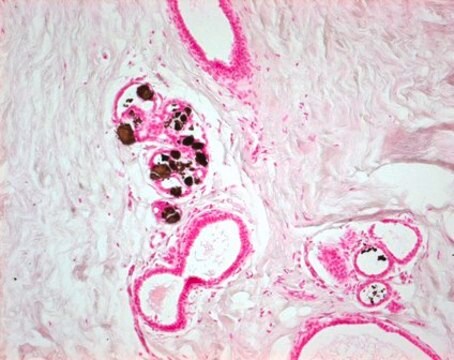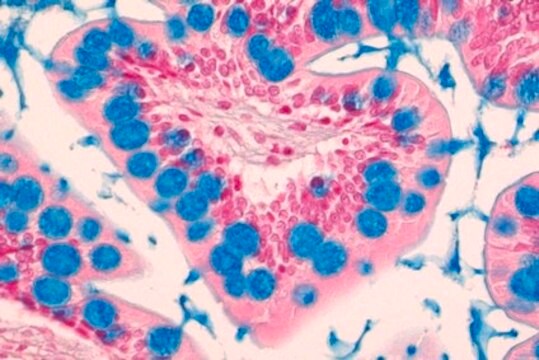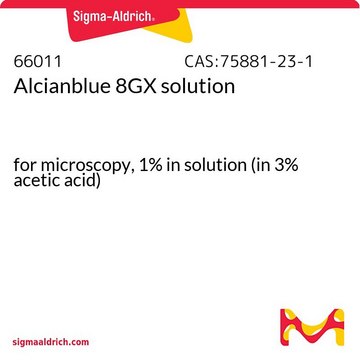1.06278
Alizarin red S mono sodiumsalt (C.I. 58005)
pH indicator
Synonyme(s) :
Alizarin red S mono sodiumsalt (C.I. 58005)
About This Item
Produits recommandés
product name
Alizarin red S mono sodiumsalt (C.I. 58005), visual transition interval 4.3-6.3, yellow to pink, visual transition interval 9.4-12.0, brown-orange to violet
Perte
≤10% loss on drying, 110°C
Niveau de qualité
visual transition interval
4.3-6.3, yellow to pink
9.4-12.0, brown-orange to violet
Amax
418-424 nm (buffer pH 4.3
buffer pH 4.3
1 buffer pH 4.3)
444-450 nm (buffer pH 9.4)
510-517 nm (buffer pH 6.3)
554-558 nm (buffer pH 12.0)
Température de stockage
2-30°C
InChI
1S/C14H8O7S.Na/c15-11-6-3-1-2-4-7(6)12(16)10-8(11)5-9(22(19,20)21)13(17)14(10)18;/h1-5,17-18H,(H,19,20,21);/q;+1/p-1
Clé InChI
HFVAFDPGUJEFBQ-UHFFFAOYSA-M
Catégories apparentées
Description générale
Application
- A ratiometric fluorescence strategy based on inner filter effect for Cu(2+)-mediated detection of acetylcholinesterase.: This study utilizes Alizarin Red S to develop a fluorescence-based method for detecting copper ions and acetylcholinesterase activity, important for environmental monitoring and medical diagnostics (Li et al., 2021 doi:10.1007/s00604-021-05044-0).
- Multiplex SERS Chemosensing of Metal Ions via DNA-Mediated Recognition.: Explores the complexation of Alizarin Red S with different metal ions, utilizing Surface-Enhanced Raman Spectroscopy (SERS) for sensitive detection, which can be applied in environmental analysis and health sciences (Guerrini and Alvarez-Puebla, 2019 doi:10.1021/acs.analchem.9b02385).
- Capsicum-Derived Biomass Quantum Dots Coupled with Alizarin Red S as an Inner-Filter-Mediated Illuminant Nanosystem for Imaging of Intracellular Calcium Ions.: This innovative approach uses Alizarin Red S in a composite nanosystem for advanced imaging techniques to monitor intracellular activities, offering potential in biomedical research and diagnostics (Chen et al., 2018 doi:10.1021/acs.analchem.8b04055).
- Ratiometric fluorescent probe based on gold nanoclusters and alizarin red-boronic acid for monitoring glucose in brain microdialysate.: Highlights the application of Alizarin Red S in developing a glucose monitoring system, which is critical for understanding metabolic processes in neurological studies (Wang et al., 2014 doi:10.1021/ac5023293).
Remarque sur l'analyse
1st transition range: pH 4.3 - pH 6.3 Lightly yellow - pink
2nd transition range: pH 9.4 - pH 12.0 Brown orange - violet
Absorption maximum λ 1 (buffer pH 4.3): 418 - 424 nm
Absorption maximum λ 2 (buffer pH 6.3): 510 - 517 nm
Absorption maximum λ 3 (buffer pH 9.4): 444 - 450 nm
Absorption maximum λ 4 (buffer pH 12.0): 554 - 558 nm
Spec. Absorptivity A 1%/1cm (λ1max; 0.01 g/l; buffer pH 4.3; calc. on dried substance): 135 - 180
Spec. Absorptivity A 1%/1cm (λ2max; 0.01 g/l; buffer pH 6.3; calc. on dried substance): 145 - 210
Spec. Absorptivity A 1%/1cm (λ3max; 0.01 g/l; buffer pH 9.4; calc. on dried substance): 170 - 230
Spec. Absorptivity A 1%/1cm (λ4max; 0.01 g/l; buffer pH 12.0; calc. on dried substance): 340 - 520
Loss on drying (110 °C): ≤ 10 %
Code de la classe de stockage
11 - Combustible Solids
Classe de danger pour l'eau (WGK)
WGK 3
Point d'éclair (°F)
Not applicable
Point d'éclair (°C)
Not applicable
Certificats d'analyse (COA)
Recherchez un Certificats d'analyse (COA) en saisissant le numéro de lot du produit. Les numéros de lot figurent sur l'étiquette du produit après les mots "Lot" ou "Batch".
Déjà en possession de ce produit ?
Retrouvez la documentation relative aux produits que vous avez récemment achetés dans la Bibliothèque de documents.
Les clients ont également consulté
Notre équipe de scientifiques dispose d'une expérience dans tous les secteurs de la recherche, notamment en sciences de la vie, science des matériaux, synthèse chimique, chromatographie, analyse et dans de nombreux autres domaines..
Contacter notre Service technique